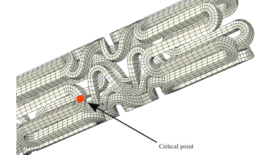Nowadays, cardiovascular disease represents a major global health care problem. To tackle this problem, the employment of stents has been considered a promising and effective approach.
Although stent design is considered a relatively mature topic, recently, fatigue failure has emerged as one main cause of stent drawback. Stents have to withstand both their initial deployment within the artery and the long-term service loading induced by the pulsatile pressure. Particularly, the US Food and Drug Administration (2010) recommends at least 10 years service for such devices without exhibiting failure, equivalent to 400 million loading cycles. Therefore, their design lies within the high- and very high-cycle fatigue.
Recently, the work [P1] has presented a fatigue life numerical method for the analysis of cardiovascular balloon-expandable stainless steel stents. The method is based on a two-scale continuum damage mechanics model. Numerical simulations predict a number of cycles up to microcrack initiation of 64 million for a PalmazShatz stent model and 53 million for a Cypher stent model. This is equivalent to approximately 22 and 18 months of the heart pumping in an average human adult, respectively.
The recent work [P2] focuses on the introduction of a computational approach for the lifetime assessment of balloon-expandable stents. The methodology is based on the global computational approach to fatigue. Particularly, the criterion by Dang Van is calibrated on suitable experimental data on 316L steel microscopic components. Several aspects affecting stent lifetime, such as the applied cyclic loading including systolic-diastolic pressurization and bending, are discussed. The generality of the proposed methodology encourages further investigations of such an approach for its application to other materials or small-scale components.
Ongoing work is focusing on the fatigue modeling of shape memory alloys and in proposing fatigue criteria to be used for the fatigue analysis of stents. Moreover, the employment of crystal plasticity models is the object of ongoing work.
Main collaborations
- CNRS Ecole Polytechnique Palaiseau France, Prof. A. Costantinescu
Group publications
- [P1] H.A.F. Argente dos Santos, F. Auricchio, M. Conti. Fatigue life assessment of cardiovascular balloon-expandable stents: A two-scale plasticity–damage model approach. Journal of the Mechanical Behavior of Biomedical Materials, vol 15, pp. 78-92 (2012)
- [P2] F. Auricchio, A. Constantinescu, M. Conti, G. Scalet. A computational approach for the lifetime prediction of cardiovascular balloon-expandable stents. International Journal of Fatigue, vol. 75, pp. 69–79. (2015)
- [P3] F. Auricchio, A. Constantinescu, G. Scalet. Fatigue of 316L stainless steel notched µm-size components. Published online on International Journal of Fatigue, vol. 68, pp. 231-247 (2014)
- [P4] F. Auricchio, A. Constantinescu, M. Conti, G. Scalet. Fatigue of Metallic Stents: From Clinical Evidence to Computational Analysis, Annals of Biomedical Engineering, vol. 44, pp. 287-301 (2016).
- [P5] F. Auricchio, A. Constantinescu, C. Menna, G. Scalet. A shakedown analysis of high cycle fatigue of shape memory alloys, International Journal of Fatigue, vol. 87, pp. 112-123 (2016).



